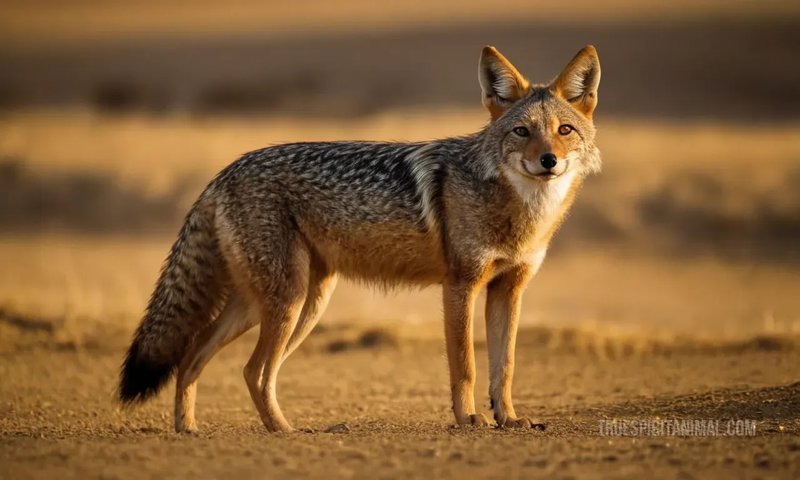
So, how do golden jackals really stack up in the intelligence department? Much like your favorite buddy who can always figure out a puzzle or outsmart a game, the golden jackal shows an impressive mix of social intelligence, problem-solving skills, and hunting strategies. Let’s dive into the world of these cunning creatures and discover just how smart they really are.
What Is a Golden Jackal?
Golden jackals (Canis aureus) are medium-sized mammals that belong to the dog family, Canidae. Their sleek, yellowish-brown coats and bushy tails set them apart from other similar species. You might find them roaming the plains and forests of Africa, Asia, and even parts of Southeastern Europe, often in open country or near villages.
You might be wondering how these animals fit into the ecosystem. Golden jackals are versatile scavengers and hunters. They thrive in diverse environments, showcasing their adaptability. Their diet mainly consists of small mammals, birds, fruits, and carrion. This omnivorous diet means they can adjust to changing conditions, which is a clever survival strategy.
Their social structures can vary, too. Golden jackals can be solitary, or they may form small family groups. This flexibility in social behavior is a key aspect of their intelligence, allowing them to thrive in different situations.
Cognitive Abilities of Golden Jackals
Golden jackals are often underestimated in terms of intelligence, but studies have shown that they possess notable cognitive abilities. Much like a strategic board game player, they can adapt their behavior based on their environment and the challenges they face. Let’s explore some of their key cognitive traits.
One of the most remarkable abilities of golden jackals is their problem-solving skills. They can figure out how to access food hidden in complex environments, such as navigating through thick underbrush or finding ways to deter other scavengers. This kind of resourcefulness highlights their ability to think critically.
Another interesting point is their social intelligence. Golden jackals often communicate using vocalizations, body language, and even facial expressions. They can recognize pack dynamics, ensuring they can work together when hunting or defending their territory. By observing one another and learning from past experiences, these animals enhance their social bonds and increase their chances of survival.
Hunting Strategies of Golden Jackals
When it comes to hunting, golden jackals demonstrate impressive teamwork and strategic planning. You might be surprised to learn that they often hunt in pairs or small family groups. This cooperation not only helps them take down larger prey but also increases their efficiency.
Their hunting tactics vary based on the situation. For example, they might use a stalking technique to quietly approach their target or employ a surprise attack to catch their prey off guard. This flexibility is a testament to their cognitive skills. They can quickly assess what method works best depending on the type of animal they’re targeting.
Furthermore, golden jackals are skilled at utilizing their environment. They often take advantage of the cover provided by tall grass or bushes, making it easier to ambush unsuspecting animals. This awareness of their surroundings shows a level of intelligence that is essential for successful hunting and long-term survival.
Communication Patterns
Another intriguing aspect of golden jackal behavior is their communication. Like your friends who have their unique way of signaling each other in a crowded room, golden jackals use a variety of sounds and body language to convey messages to one another.
Their vocalizations range from howls to yips and growls, each serving a specific purpose. For instance, howling can help them establish territory or coordinate group movements. Additionally, they use body language—such as tail positions and facial expressions—to communicate feelings and intentions. This nuanced way of expressing themselves indicates a complex level of social intelligence.
Moreover, golden jackals are known to be quite vocal, especially during the mating season or when defending their territory. Their ability to communicate effectively in different social contexts plays a crucial role in their survival and success as a species.
Adaptability and Environmental Awareness
Golden jackals are true survivors. Their adaptability allows them to thrive in various environments, from deserts to forests or even near human settlements. You could say they are the ultimate “survivalists” of the animal world!
This adaptability is largely due to their keen environmental awareness. They can assess their surroundings and determine the best strategies to find food, avoid danger, or establish territory. For example, golden jackals have been known to raid farms and take advantage of discarded food, showcasing their cleverness in capitalizing on human presence.
Additionally, their ability to adjust their diet based on available resources is a key factor in their survival. If their usual prey becomes scarce, they won’t hesitate to shift to scavenging or targeting smaller animals. This flexibility is a prime example of their intelligence and instinct.
The Role of Social Learning
Social learning plays a significant role in the cognitive abilities of golden jackals. Much like how we learn from our friends and family, golden jackals can gain knowledge by observing others in their pack. This form of learning can involve hunting techniques, foraging skills, or even recognizing predators.
For instance, a young jackal might watch older, more experienced members of its pack while they hunt. By doing so, it can learn the best approaches to stalking prey or how to work together with others. This ability to learn from peers enhances their chances of survival and success in the wild.
The impact of social learning also extends to their social structures. As pack dynamics evolve, the younger members adapt and adopt strategies from their elders, ensuring that valuable knowledge is passed down through generations.
In conclusion, golden jackals may not be the first animals that come to mind when you think about wildlife intelligence, but they certainly hold their own in cognitive abilities and behavior. From their problem-solving skills and effective communication to their adaptability and social learning capabilities, these clever creatures reveal the many layers of animal intelligence.
So, next time you hear about a golden jackal, remember they are more than just a wild dog. They’re fascinating beings that have carved out a niche for themselves in the wilderness. Their behaviors and adaptability remind us that intelligence comes in many forms, and sometimes, the most remarkable minds are those that operate quietly in the background.

